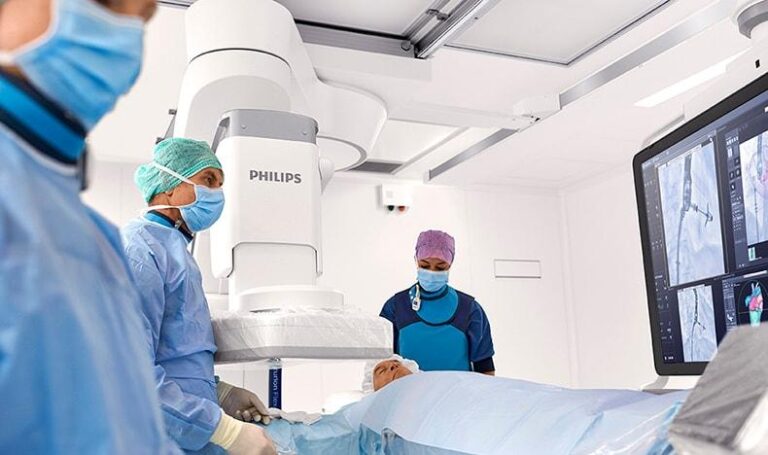Partnering for a Sustainable Cath Lab at Rennes University Hospital: A Case Study with Philips
In an era where healthcare sustainability is paramount, the collaboration between Rennes University Hospital and Philips stands out as a pioneering model for integrating advanced technology with eco-friendly practices. This case study examines how the strategic partnership aims to enhance patient care while minimizing environmental impact through the development of a state-of-the-art catheterization lab. By combining innovative medical solutions with a commitment to sustainability, this initiative not only redefines operational efficiency but also sets a new standard for hospitals worldwide. As leaders in the healthcare industry gather to explore the future of sustainable practices, the success of Rennes University Hospital serves as a beacon of what can be achieved through dedicated cooperation and forward-thinking solutions.
Innovative Approaches to Sustainable Practices in Cath Labs
At Rennes University Hospital, a pioneering partnership with Philips is redefining how cath labs operate with a focus on sustainability. By integrating advanced imaging technologies and energy-efficient systems, the project aims to minimize the environmental impact of cardiology services. Notable innovations include the adoption of LED lighting, which significantly conserves energy, and smart recycling protocols for medical waste, enhancing both operational efficiency and compliance with environmental standards. The collaboration is not only about reducing carbon footprints but also about creating a healthier work environment for staff and patients alike.
The approach fosters engagement through a range of sustainability initiatives, including regular training sessions for medical personnel on best practices for resource management. Additionally, the use of real-time data analytics aids in monitoring resource consumption, thereby facilitating ongoing improvements. The positive impact of these efforts is underscored by early feedback data collected from staff, showing increased satisfaction and pride in working within a sustainable framework. The case study illustrates how integrating sustainability into cath lab operations can lead to meaningful change while enhancing the quality of patient care.
Collaboration between Philips and Rennes University Hospital: A Model for Success
In a groundbreaking initiative, Philips has teamed up with Rennes University Hospital to redefine the operational standards of catheterization laboratories (cath labs). This partnership has harnessed cutting-edge technology and innovative strategies to deliver a sustainable and efficient healthcare environment. Key aspects of this collaboration include:
- Advanced Imaging Solutions: Utilizing Philips’ state-of-the-art imaging technologies to enhance procedural accuracy and patient outcomes.
- Sustainability Initiatives: Implementing eco-friendly practices to minimize waste and energy consumption within the cath lab.
- Training and Development: Comprehensive training programs for medical personnel to ensure proficiency in utilizing new technologies.
This model of collaboration serves as a benchmark for healthcare partnerships, demonstrating how innovation and sustainability can coexist within hospital settings. The project has already begun to yield significant improvements in patient care and operational efficiency, as illustrated by the following metrics:
| Metric | Before Collaboration | After Collaboration |
|---|---|---|
| Procedure Duration (minutes) | 90 | 75 |
| Patient Satisfaction (%) | 80 | 95 |
| Energy Consumption (kWh/day) | 200 | 150 |
Key Insights from the Case Study on Environmental Impact Reduction
In a groundbreaking collaboration, Philips and Rennes University Hospital successfully developed a sustainable cath lab, demonstrating significant achievements in minimizing environmental impact. The case study illuminates the proactive measures taken towards reducing carbon emissions and resource consumption. Key achievements include:
- Energy Efficiency: The innovative design of the cath lab incorporated energy-efficient technologies, resulting in a 30% reduction in energy usage compared to conventional labs.
- Waste Management: Implementation of strict protocols for waste segregation led to a 40% increase in recycling rates, effectively decreasing landfill contributions.
- Sustainable Materials: The use of environmentally friendly materials in lab construction and equipment further minimized the carbon footprint.
The impact of this initiative extends beyond immediate environmental benefits, as it fosters a mindset of sustainability among healthcare professionals. Moreover, the partnership emphasizes the importance of innovation in addressing ecological challenges faced by healthcare facilities. Notable statistics from the initiative highlight outcomes such as:
| Feature | Before Project | After Project |
|---|---|---|
| CO2 Emissions (tons/year) | 150 | 105 |
| Water Usage (liters/year) | 100,000 | 70,000 |
| Electronic Waste (kg/year) | 5,000 | 3,000 |
Strategic Recommendations for Future Sustainability Initiatives in Healthcare
The success of the cath lab sustainability initiative at Rennes University Hospital serves as a guide for future initiatives in healthcare. To enhance sustainability, hospitals can focus on technology integration that complements eco-friendly practices. Key actions may include:
- Implementing energy-efficient medical equipment to reduce power consumption.
- Utilizing sustainable materials in lab construction and renovation.
- Establishing partnerships with green technology firms for innovative solutions.
Data tracking and management systems should also be prioritized to streamline operations while minimizing waste. Hospitals are encouraged to:
- Monitor resource utilization closely to identify areas for improvement.
- Adopt circular economy practices for medical disposables.
- Engage staff through training programs that emphasize sustainability goals.
By initiating these strategies, healthcare facilities could not only improve their environmental impact but also enhance patient outcomes through more efficient and responsible care practices.
Insights and Conclusions
In conclusion, the partnership between Rennes University Hospital and Philips represents a significant step forward in the pursuit of sustainable healthcare solutions. By focusing on innovative technologies and energy-efficient practices, they not only enhance operational effectiveness within the cath lab but also set a benchmark for other facilities aiming to reduce their environmental footprint. This case study not only highlights the potential for collaboration to drive change in the healthcare sector but also underscores the growing importance of sustainability in medical practices. As hospitals worldwide look toward the future, initiatives like these are paving the way for a more responsible and eco-friendly healthcare system. The journey to a greener medical landscape is just beginning, and Rennes University Hospital and Philips are leading the charge.




